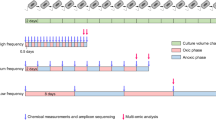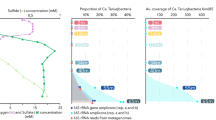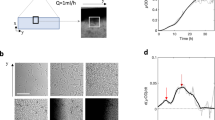Abstract
Understanding the microbial degradation of Microcystis biomass is crucial for determining the ecological consequences of Microcystis blooms in freshwater lakes. The purpose of this study was to identify bacteria involved in the anaerobic degradation of Microcystis blooms. Microcystis scum was anaerobically incubated for 90 days at three temperatures (15 °C, 25 °C and 35 °C). We used terminal restriction fragment length polymorphism (T-RFLP) analysis of bacterial 16S rRNA genes, followed by cloning and sequencing of selected samples, to reveal the community composition of bacteria and their dynamics during decomposition. Clostridium spp. were found to be the most dominant bacteria in the incubations, accounting for 72% of the sequenced clones. Eight new clusters or subclusters (designated CLOS.1–8) were identified in the Clostridium phylogenetic tree. The bacterial populations displayed distinct successions during Microcystis decomposition. Temperature had a strong effect on the dynamics of the bacterial populations. At 15 °C, the initial dominance of a 207-bp T-RF (Betaproteobacteria) was largely substituted by a 227-bp T-RF (Clostridium, new cluster CLOS.2) at 30 days. In contrast, at 25 °C and 35 °C, we observed an alternating succession of the 227-bp T-RF and a 231-bp T-RF (Clostridium, new cluster CLOS.1) that occurred more than four times; no one species dominated the flora for the entire experiment. Our study shows that novel Clostridium clusters and their diverse consortiums dominate the bacterial communities during anaerobic degradation of Microcystis, suggesting that these microbes' function in the degradation process.
Similar content being viewed by others
Log in or create a free account to read this content
Gain free access to this article, as well as selected content from this journal and more on nature.com
or
Accession codes
References
Acinas SG, Haverkamp THA, Huisman J, Stal LJ . (2009). Phenotypic and genetic diversification of Pseudanabaena spp. (cyanobacteria). ISME J 3: 31–46.
Ashelford KE, Chuzhanova NA, Fry JC, Jones AJ, Weightman AJ . (2006). New screening software shows that most recent large 16S rRNA gene clone libraries contain chimeras. Appl Environ Microbiol 71: 5731–5734.
Burrell PC, O’Sullivan C, Song H, Clarke WP, Blackall LL . (2004). Identification, detection, and spatial resolution of Clostridium populations responsible for cellulose degradation in a methanogenic landfill leachate bioreactor. Appl Environ Microbiol 70: 2414–2419.
Castresana J . (2000). Selection of conserved blocks from multiple alignments for their use in phylogenetic analysis. Mol Biol Evol 17: 540–552.
Chang JJ, Chen WE, Shih SY, Yu SJ, Lay JJ, Wen FS et al. (2006). Molecular detection of the clostridia in an anaerobic biohydrogen fermentation system by hydrogenase mRNA-targeted reverse transcription-PCR. Appl Microbiol Biotechnol 70: 598–604.
Chen Y, Qin B, Teubner K, Dokulil MT . (2003). Long-term dynamics of phytoplankton assemblages: Microcystis-domination in Lake Taihu, a large shallow lake in China. J Plankton Res 25: 445–453.
Cole JR, Chai B, Farris RJ, Wang Q, Kulam-Syed-Mohideen AS, McGarrell DM et al. (2007). The ribosomal database project (RDP-II): introducing myRDP space and quality controlled public data. Nucleic Acids Res 35: D169–D172.
Collins MD, Lawson PA, Willems A, Cordoba JJ, Fernandez-Garayzabal J, Garcia P et al. (1994). The phylogeny of the genus Clostridium: proposal of five new genera and eleven new species combinations. Int J Syst Bacteriol 44: 812–826.
Conley DJ, Paerl HW, Howarth RW, Boesch DF, Seitzinger SP, Havens KE et al. (2009). ECOLOGY: controlling eutrophication: nitrogen and phosphorus. Science 323: 1014–1015.
Felsenstein J . (1984). Distance methods for inferring phylogenies: a justification. Evolution 38: 16–24.
Field D, Garrity G, Gray T, Morrison N, Selengut J, Sterk P et al. (2008). The minimum information about a genome sequence (MIGS) specification. Nat Biotechnol 26: 541–547.
Groâkopf R, Janssen PH, Liesack W . (1998). Diversity and structure of the methanogenic community in anoxic rice paddy soil microcosms as examined by cultivation and direct 16S rRNA gene sequence retrieval. Appl Environ Microbiol 64: 960–969.
Iyer AV, Blinkova AL, Yang S-Y, Harrison M, Tepp WH, Jacobson MJ et al. (2008). Clostridium taeniosporum is a close relative of the Clostridium botulinum Group II. Anaerobe 14: 318–324.
Jin F, Yamasato K, Toda K . (1988). Clostridium thermocopriae sp. nov., a cellulolytic thermophile from animal feces, compost, soil, and a hot spring in Japan. Int J Syst Bacteriol 38: 279–281.
Johnson EA, Sakajoh M, Halliwell G, Madia A, Demain AL . (1982). Saccharification of complex cellulosic substrates by the cellulase system from Clostridium thermocellum. Appl Environ Microbiol 43: 1125–1132.
Krogius-Kurikka L, Kassinen A, Paulin L, Corander J, Mäkivuokka H, Tuimala J et al. (2009). Sequence analysis of percent G+C fraction libraries of human faecal bacterial DNA reveals a high number of Actinobacteria. BMC Microbiol 9: 68–80.
Kuhner MK, Felsenstein J . (1994). A simulation comparison of phylogeny algorithms under equal and unequal evolutionary rates. Mol Biol Evol 11: 459–468 (erratum 1995; 12: 525).
Liu WT, Marsh TL, Cheng H, Forney LJ . (1997). Characterization of microbial diversity by determining terminal restriction fragment length polymorphisms of genes encoding 16S rRNA. Appl Environ Microbiol 63: 4516–4522.
Lynd LR, Weimer PJ, van Zyl WH, Pretorius IS . (2002). Microbial cellulose utilization: fundamentals and biotechnology. Microbiol Mol Biol Rev 66: 506–577.
Macalady JL, Dattagupta S, Schaperdoth I, Jones DS, Druschel G, Eastman D . (2008). Niche differentiation among sulfur-oxidizing bacterial populations in cave waters. ISME J 2: 590–601.
Manage PM, Kawabata Z, Nakano S, Nishibe Y . (2000). Isolation and properties of the bacterium Alcaligenes denitrificans inhibiting the growth of Microcystis sp. Nippon Rikusui Gakkai Taikai Koen Yoshishu 65: 70.
Murashima K, Kosugi A, Doi RH . (2002). Determination of subunit composition of Clostridium cellulovorans cellulosomes that degrade plant cell walls. Appl Environ Microbiol 68: 1610–1615.
Örlygsson J, Krooneman J, Collins MD, Pasual C, Gottschal JC . (1996). Clostridium acetireducens sp. nov., a novel amino acid-oxidizing, acetate-reducing anaerobic bacterium. Int J Syst Bacteriol 46: 454–459.
Paerl HW, Fulton RS, Moisander PH, Dyble J . (2001). Harmful freshwater algal blooms, with an emphasis on Cyanobacteria. Scientific World 1: 76–113.
Paerl HW, Huisman J . (2008). Blooms like it hot. Science 320: 57–58.
Paerl HW, Pinckney JL, Steppe TF . (2000). Cyanobacterial–bacterial mat consortia: examining the functional unit of microbial survival and growth in extreme environments. Environ Microbiol 2: 11–26.
Rashidan KK, Bird DF . (2001). Role of predatory bacteria in the termination of a cyanobacterial bloom. Microb Ecol 41: 91–105.
Ren N, Xing D, Rittmann BE, Zhao L, Xie T, Zhao X . (2006). Microbial community structure of ethanol type fermentation in bio-hydrogen production. Environ Microbiol 9: 1112–1125.
Rui J, Peng J, Lu Y . (2009). Succession of bacterial populations during plant residue decomposition in rice field soil. Appl Environ Microbiol 75: 4879–4886.
Schauer M, Kamenik C, Hahn MW . (2005). Ecological differentiation within a cosmopolitan group of planktonic freshwater bacteria (SOL Cluster, Saprospiraceae, Bacteroidetes). Appl Environ Microbiol 71: 5900–5907.
Seedorf H, Fricke WF, Veith B, Brüggemann H, Liesegang H, Strittmatter A et al. 2008. The genome of Clostridium kluyveri, a strict anaerobe with unique metabolic features. Proc Natl Acad Sci USA 105: 2128–2133.
Sridhar J, Eiteman MA, Wiegel JW . (2000). Elucidation of enzymes in fermentation pathways used by Clostridium thermosuccinogenes growing on inulin. Appl Environ Microbiol 66: 246–251.
Stackebrandt E, Kramer I, Swiderski J, Hippe H . (1999). Phylogenetic basis for a taxonomic dissection of the genus Clostridium. FEMS Immunol Med Microbiol 24: 253–258.
Swofford DL . (1998). PAUP*: Phylogenetic Analysis Using Parsimony (* and other methods), Version 4. Sinauer: Sunderland, MA.
Tajima K, Arai S, Ogata K, Nagamine T, Matsui H, Nakamura M et al. (2000). Rumen bacterial community transition during adaptation to high-grain diet. Anaerobe 6: 273–284.
Tamura K, Dudley J, Nei M, Kumar S . (2007). MEGA4: Molecular evolutionary genetics analysis (MEGA) software version 4.0. Mol Biol Evol 24: 1596–1599.
Tateno Y, Takezaki N, Nei M . (1994). Relative efficiencies of the maximum-likelihood, neighbor-joining, and maximum-parsimony methods when substitution rate varies with site. Mol Biol Evol 11: 261–277.
ter Braak CJF, Verdonschot PFM . (1995). Canonical correspondence analysis and related multivariate methods in aquatic ecology. Aquat Sci 57: 255–289.
Thompson JD, Gibson TJ, Plewniak F, Jeanmougin F, Higgins DG . (1997). The CLUSTAL_X windows interface: flexible strategies for multiple sequence alignment aided by quality analysis tools. Nucleic Acids Res 25: 4876–4882.
Van Dyke MI, McCarthy AJ . (2002). Molecular biological detection and characterization of Clostridium populations in municipal landfill sites. Appl Environ Microbiol 68: 2049–2053.
Verberkmoes N, Russell AL, Shah M, Godzik A, Rosenquist M, Halfvarson J et al. (2009). Shotgun metaproteomics of the human distal gut microbiota. ISME J 3: 179–189.
Wang H, Lu J, Wang W, Yang L, Chen Y . (2006). Methane fluxes from the littoral zone of hypereutrophic Taihu Lake, China. J Geophys Res 111: D17109.
Wang Q, Garrity GM, Tiedje JM, Cole JR . (2007). Naive Bayesian classifier for rapid assignment of rRNA sequences into the new bacterial taxonomy. Appl Environ Microbiol 73: 5261–5267.
Wang X, Hoefel D, Saint CP, Monis PT, Jin B . (2007). The isolation and microbial community analysis of hydrogen producing bacteria from activated sludge. J Appl Microbiol 103: 1415–1423.
Weisburg WG, Barns SM, Pelletier DA, Lane DJ . (1991). 16S ribosomal DNA amplification for phylogenetic study. Appl Environ Microbiol 173: 697–703.
Xing P, Hahn MW, Wu QL . (2009). Low taxon richness of bacterioplankton in high-altitude lakes of the Eastern Tibetan Plateau, with a predominance of Bacteroidetes and Synechococcus spp. Appl Environ Microbiol 75: 7017–7025.
Yokoyama H, Waki M, Moriya N, Yasuda T, Tanaka Y, Haga K . (2007). Effect of fermentation temperature on hydrogen production from cow waste slurry by using anaerobic microflora within the slurry. Appl Microbiol Biotechnol 74: 474–483.
Zhang R, Thiyagarajan V, Qian P . (2008). Evaluation of terminal-restriction fragment length polymorphism analysis in contrasting marine environments. FEMS Microbiol Ecol 65: 169–178.
Acknowledgements
We thank Xing Jin and Chengsheng Long for their assistance with the experiment. This work was supported by the Knowledge Innovation Project of the Chinese Academy of Sciences (KZCX2-YW-JC302; KZCX1-YW-14-1), the National Basic Research Program of China (973 program) (No. 2008CB418104) and the Jiangsu Provincial Science Foundation (BK2009024).
Author information
Authors and Affiliations
Corresponding author
Additional information
Supplementary Information accompanies the paper on The ISME Journal website
Supplementary information
Rights and permissions
About this article
Cite this article
Xing, P., Guo, L., Tian, W. et al. Novel Clostridium populations involved in the anaerobic degradation of Microcystis blooms. ISME J 5, 792–800 (2011). https://doi.org/10.1038/ismej.2010.176
Received:
Revised:
Accepted:
Published:
Issue date:
DOI: https://doi.org/10.1038/ismej.2010.176
Keywords
This article is cited by
-
Extensive Carbon Contribution of Inundated Terrestrial Plants to Zooplankton Biomass in a Eutrophic Lake
Microbial Ecology (2023)
-
Transcriptional response of Microcystis aeruginosa to the recruitment promoting-benthic bacteria
Journal of Oceanology and Limnology (2022)
-
Regime transition Shapes the Composition, Assembly Processes, and Co-occurrence Pattern of Bacterioplankton Community in a Large Eutrophic Freshwater Lake
Microbial Ecology (2022)
-
Characterization of odorants in contrasting ecotypes of Lake Taihu: algae-dominated versus macrophyte-dominated zones
Environmental Science and Pollution Research (2020)
-
Phenotype changes of cyanobacterial and microbial distribution characteristics of surface sediments in different periods of cyanobacterial blooms in Taihu Lake
Aquatic Ecology (2020)



